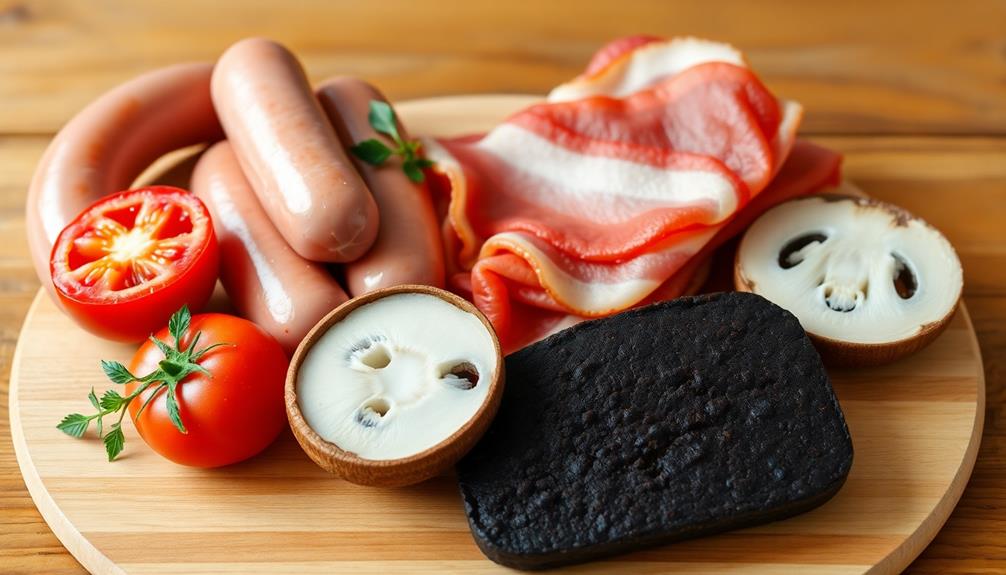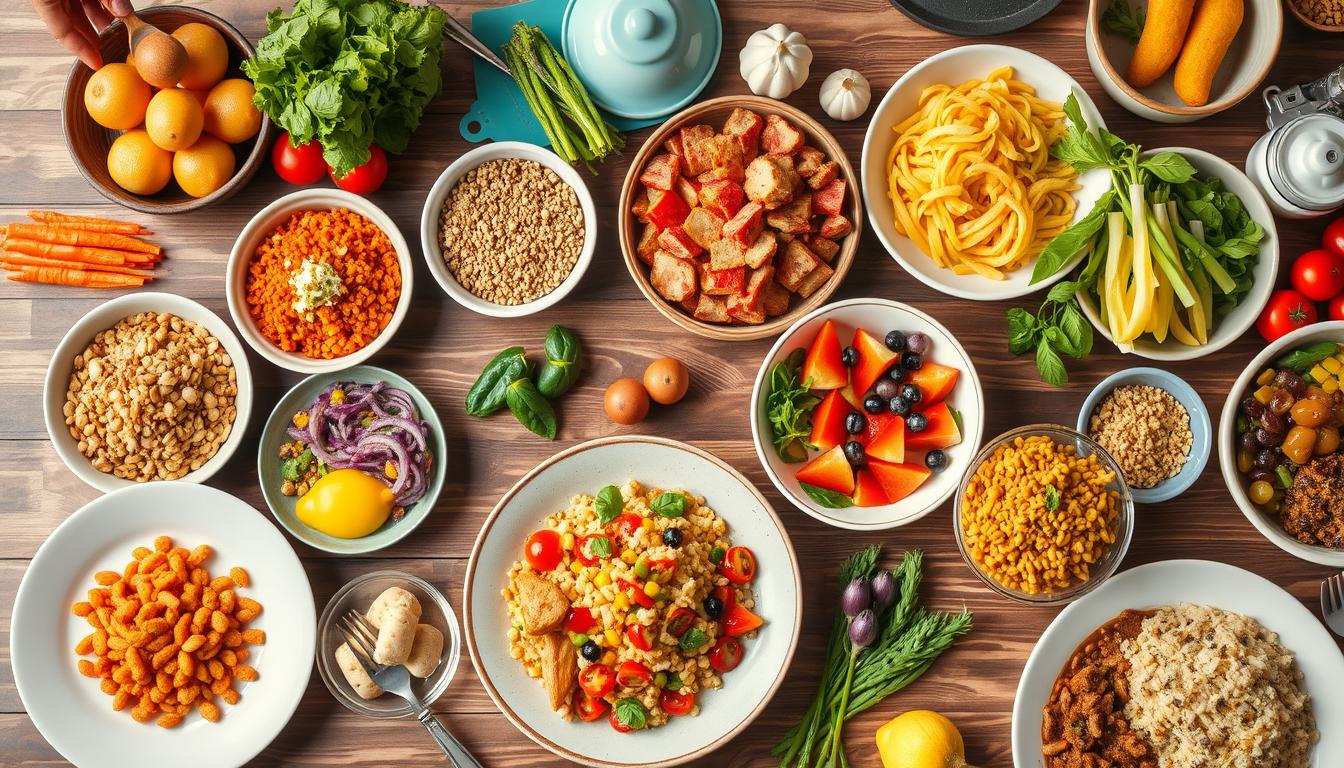Get ready to indulge in a mouthwatering start to your day with the full English breakfast! This beloved British culinary tradition combines a hearty assortment of savory ingredients that have been perfected over centuries. Dive into crispy bacon, juicy sausages, perfectly cooked eggs, sautéed mushrooms, and grilled tomatoes, all served alongside golden toast. Each component brings its own unique texture and flavor, creating a balanced and satisfying meal that'll fuel you up. Whether you're enjoying it in a cozy cafe or your own kitchen, the full English breakfast is a true taste of British gastronomic heritage. There's more to discover about this iconic dish!
Key Takeaways
- The Full English Breakfast is a traditional British dish rooted in the culinary needs of farmers and workers, reflecting the country's gastronomic heritage.
- The dish is a balanced meal with protein, carbohydrates, and fats, providing energy to start the day and reducing the need for snacking later.
- The essential ingredients, including bacon, sausages, eggs, tomatoes, and mushrooms, contribute unique textures and flavors, creating a hearty and satisfying breakfast.
- The cooking process involves techniques like crisping bacon, juicing sausages, and sautéing mushrooms, ensuring optimal flavor and texture in each component.
- The Full English Breakfast is enjoyed in cozy cafes and charming country inns, serving as a communal meal that evokes nostalgia and comfort for many.
History
The full English breakfast has its roots deep in British culinary history. It all started centuries ago, when farmers and workers needed a hearty meal to fuel their long, hard days. They'd sit down to a plate piled high with eggs, bacon, sausages, and more. This satisfying spread became a beloved tradition, a way to start the day off right.
Over time, the full English breakfast evolved, with new ingredients and cooking methods. But the core elements remained the same – a delicious combination of savory, protein-packed foods that would keep you going until lunchtime.
Today, it's a quintessential part of British culture, a comforting ritual that brings people together around the table.
Whether you're a lifelong fan or trying it for the first time, the full English breakfast is a true taste of history. So grab a fork and get ready for a mouthwatering journey through the past!
Recipe
A full English breakfast is a beloved British culinary tradition, offering a hearty and satisfying start to the day. This classic meal combines a variety of savory ingredients, each one adding its unique flavor and texture to the overall experience.
The full English breakfast is more than just a dish; it's a cultural celebration of the country's rich gastronomic heritage. From the sizzling bacon to the perfectly cooked eggs, every element is carefully orchestrated to create a harmonious and mouthwatering feast.
Ingredients:
- 2 rashers of bacon
- 2 pork sausages
- 2 eggs
- 1 tomato, halved
- 1 mushroom, sliced
- 1 slice of black pudding (optional)
- 2 slices of bread
- Butter
- Salt and pepper to taste
Instructions:
In a large skillet, cook the bacon and sausages over medium heat until they're golden brown and cooked through. Remove the bacon and sausages from the pan, leaving the rendered fat behind.
Crack the eggs into the pan and cook until the whites are set and the yolks are still runny. Add the tomato halves and mushroom slices to the pan, cooking them until they're tender. If using black pudding, add it to the pan and cook until heated through.
Toast the bread and spread with butter. Assemble the full English breakfast on a plate, placing the bacon, sausages, eggs, tomato, mushroom, and black pudding (if using) alongside the toast.
Additional Tips:
For the best results, use high-quality, fresh ingredients. The key to a successful full English breakfast is to cook each component to perfection, ensuring that the flavors and textures complement one another.
Consider adding baked beans, hash browns, or grilled tomatillos for an even more substantial and satisfying meal.
Cooking Steps
First, you'll want to get all your ingredients ready to go.
Then, start cooking up that crispy bacon and those tasty sausages.
Once that's sizzling away, you can crack some eggs and fry them sunny-side up.
Don't forget to sauté the mushrooms and grill the tomatoes too!
And of course, you'll want to toast up some bread to complete this mouthwatering Full English Breakfast.
Step 1. Prepare Ingredients Beforehand

Getting your ingredients ready beforehand can really streamline the cooking process. Having everything prepped and organized makes it a breeze to assemble your full English breakfast.
Start by laying out all the components – bacon, sausages, eggs, tomatoes, mushrooms, and bread for toast. Take a few minutes to chop, slice, and measure each item so it's ready to go when you need it.
Next, preheat your oven and griddle or skillet. This allows them to get nice and hot, perfect for quickly cooking the different elements of your breakfast.
Once your cooking surfaces are ready, you can focus on assembling the meal without any delays. The bacon and sausages will sizzle, the eggs will fry up, and the tomatoes and mushrooms will roast to perfection.
With everything prepared ahead of time, you can sit down to a piping hot, hearty full English breakfast in no time!
Step 2. Cook Bacon and Sausages

With your ingredients laid out and your cooking surfaces preheated, you can now start cooking the bacon and sausages.
Begin by laying the bacon slices in a large skillet over medium-high heat. As the bacon starts to sizzle, use a pair of tongs to flip the slices occasionally, ensuring they cook evenly on both sides. The bacon should turn crispy and golden brown, about 5-7 minutes.
Next, add the sausages to the same skillet, making sure they've enough room to brown properly. Rotate the sausages frequently with the tongs to achieve an even cook. The sausages will need about 10-12 minutes to reach a nice, juicy finish.
Keep an eye on the heat, adjusting it as needed to prevent burning.
Once the bacon and sausages are cooked to your liking, transfer them to a plate lined with paper towels to drain any excess fat. This step helps create the perfect texture for your full English breakfast.
Step 3. Cook Eggs Sunny-Side up

Next, crack the eggs into a lightly oiled non-stick skillet over medium heat.
You'll want to keep a close eye on them, gently lifting the edges with a spatula as they cook. The goal is to get the whites completely set while leaving the yolks delightfully runny. This sunny-side up style is a classic part of the Full English Breakfast.
As the eggs cook, you'll see the whites gradually turn opaque and the edges begin to crisp up.
Be patient and resist the urge to flip them – you want those beautiful golden yolks to remain intact. Once the whites are set, remove the skillet from the heat. The residual warmth will continue cooking the yolks to perfection.
Gently transfer the eggs to your plate, being careful not to break the yolks.
Season them with a sprinkle of salt and pepper, or any other desired seasonings. The sunny-side up eggs are now ready to be enjoyed as part of your magnificent Full English Breakfast.
Step 4. Sautéed Mushrooms and Grilled Tomatoes

Alongside the gently cooked eggs, the savouriness of sautéed mushrooms and the vibrant burst of grilled tomatoes will elevate your Full English Breakfast.
Start by slicing the mushrooms and placing them in a hot pan with a drizzle of olive oil. Sauté the mushrooms, stirring occasionally, until they've softened and developed a delightful golden-brown hue.
Meanwhile, halve the tomatoes and season them with a sprinkle of salt and pepper. Place the tomato halves on a grill pan or baking sheet and let them sizzle until they're slightly charred and the juices begin to release.
The combination of earthy mushrooms and juicy, sweet tomatoes will tantalize your taste buds, creating a perfect accompaniment to the other components of your hearty breakfast.
Serve the sautéed mushrooms and grilled tomatoes alongside the sunny-side up eggs for a truly satisfying start to your day.
Step 5. Toast the Bread

To complete the Full English Breakfast, toast the bread to golden perfection. Simply pop the slices into the toaster and wait for them to become crisp and lightly browned. You can use a regular toaster or even a toaster oven for this step.
Keep a close eye on the bread, as you don't want it to burn. Once it's reached your desired level of toastiness, remove the slices and place them on a plate. If you prefer your toast a bit softer, you can lightly butter the slices while they're still warm. This will help the butter melt and create a delicious, buttery flavor.
Toasting the bread is a simple but essential part of the Full English Breakfast, adding a satisfying crunch and complementing the other hearty elements on the plate. Enjoy your perfectly toasted bread as you savor the complete breakfast experience.
Final Thoughts
The full English breakfast is a culinary tradition that has endured for generations, reflecting the diverse cultural influences that have shaped British cuisine.
This beloved meal is a celebration of the country's rich history and the simple pleasures of a hearty, satisfying start to the day. From the crisp, golden-brown toast to the perfectly cooked eggs, each component of the full English breakfast plays a vital role in creating a harmonious and deeply nourishing experience.
As you savor each bite, you'll be transported to the cozy cafes and charming country inns where this iconic dish has been served for decades. As the flavors envelop your senses, you’ll find yourself reminiscing about warm, heartfelt gatherings and the simple joys of comfort food. The súp nui Vietnamese pasta soup, with its tender noodles and rich, savory broth, embodies this same sense of nostalgia and homey delight. It’s a dish that tells a story with every spoonful, connecting generations and cultures through its timeless appeal.
The full English breakfast is more than just a meal – it's a symbol of the warmth, hospitality, and pride that are at the heart of British culture.
Indulging in this beloved culinary tradition is a delightful way to celebrate the simple joys of life and connect with the rich tapestry of the nation's gastronomic heritage.
Frequently Asked Questions
What Are the Nutritional Benefits of a Full English Breakfast?
The nutritional benefits of a full English breakfast are that it provides you with a balanced mix of protein, carbohydrates, and healthy fats to fuel your body and keep you feeling satisfied throughout the morning.
Can Vegetarians or Vegans Enjoy a Full English Breakfast?
As a vegetarian or vegan, you can absolutely enjoy a hearty full English breakfast. Opt for meatless sausages, grilled tomatoes, mushrooms, and beans to create a satisfying plant-based version that aligns with your dietary preferences.
How Common Is the Full English Breakfast in Other Countries?
The full English breakfast is not as common in other countries, where local breakfast customs and preferences tend to dominate. However, you may find it offered in touristy areas or international hotels to cater to foreign visitors.
Is the Full English Breakfast a Healthy Choice for Everyday Meals?
While a full English breakfast can be a hearty and satisfying meal, it's generally not the healthiest choice for everyday meals. The high fat and calorie content can contribute to weight gain and other health issues if consumed regularly.
What Are Some Alternative Ingredients for a Full English Breakfast?
Instead of the traditional full English, try a healthier alternative with grilled tomatoes, sautéed mushrooms, scrambled eggs, and whole-grain toast. You can also include lean protein like turkey bacon or veggie sausages for a nutritious start to your day.










